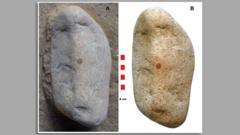The article text:
Scientists in Spain have made a groundbreaking discovery, unveiling what is believed to be the oldest complete human fingerprint, found on a painted pebble that showcases signs of artistic endeavor by Neanderthals. The rock, discovered in the San Lázaro rock shelter in Segovia, appears to depict a human face and suggests that these ancient humans may have employed art forms as early as 43,000 years ago.
Evidence points to a Neanderthal man utilizing red pigment to paint a nose on the pebble, with the strategic placement of the dot indicating potential symbolic thought. This revelation adds a significant piece to the ongoing discussion surrounding Neanderthals' artistic abilities, according to co-author María de Andrés-Herrero from the University of Complutense.
Excavations at the site began five years prior, leading to the discovery of the stone beneath 1.5 meters of sediment attributed to Neanderthal habitation. Initially, the research team found the unusually large rock lined with a distinctive red dot that resembled a human face, prompting inquiries into its origins. Subsequent analysis confirmed the use of ochre pigment, validating their hypotheses.
In collaboration with Spain's scientific police, extensive multi-spectrum analysis allowed researchers to identify the fossilized fingerprint as belonging to an adult male. However, archaeologist David Álvarez Alonso noted the difficulty in firmly attributing the print to a Neanderthal due to the lack of comparative references.
During a public update, Spanish official Gonzalo Santonja remarked on the significance of this pebble, deeming it the oldest portable art object identified in Europe and possibly the only Neanderthal-created artifact of its kind. Prof. de Andrés-Herrero emphasized the importance of their findings, describing the pigment-marked pebble as a key insight into Neanderthal cognitive capacity and creative expression.
Notably, the context of the human fingerprint adds to the intrigue; found in a non-utilitarian setting, it suggests that the dot was created with the intent of artistic representation. Prof. Alonso speculated that a Neanderthal might have been drawn to the stone's features and deliberately marked it with ochre. "Our findings indicate that the mark was not a mere accident," Alonso stated, as the red pigment is not native to the shelter, implicating intentionality in its placement.
The research, published in the journal Archaeological and Anthropological Sciences, concludes that the pebble from the San Lázaro rock-shelter is not just a random artifact but a visual symbol, potentially regarded as a piece of portable art by the Neanderthals.
Scientists in Spain have made a groundbreaking discovery, unveiling what is believed to be the oldest complete human fingerprint, found on a painted pebble that showcases signs of artistic endeavor by Neanderthals. The rock, discovered in the San Lázaro rock shelter in Segovia, appears to depict a human face and suggests that these ancient humans may have employed art forms as early as 43,000 years ago.
Evidence points to a Neanderthal man utilizing red pigment to paint a nose on the pebble, with the strategic placement of the dot indicating potential symbolic thought. This revelation adds a significant piece to the ongoing discussion surrounding Neanderthals' artistic abilities, according to co-author María de Andrés-Herrero from the University of Complutense.
Excavations at the site began five years prior, leading to the discovery of the stone beneath 1.5 meters of sediment attributed to Neanderthal habitation. Initially, the research team found the unusually large rock lined with a distinctive red dot that resembled a human face, prompting inquiries into its origins. Subsequent analysis confirmed the use of ochre pigment, validating their hypotheses.
In collaboration with Spain's scientific police, extensive multi-spectrum analysis allowed researchers to identify the fossilized fingerprint as belonging to an adult male. However, archaeologist David Álvarez Alonso noted the difficulty in firmly attributing the print to a Neanderthal due to the lack of comparative references.
During a public update, Spanish official Gonzalo Santonja remarked on the significance of this pebble, deeming it the oldest portable art object identified in Europe and possibly the only Neanderthal-created artifact of its kind. Prof. de Andrés-Herrero emphasized the importance of their findings, describing the pigment-marked pebble as a key insight into Neanderthal cognitive capacity and creative expression.
Notably, the context of the human fingerprint adds to the intrigue; found in a non-utilitarian setting, it suggests that the dot was created with the intent of artistic representation. Prof. Alonso speculated that a Neanderthal might have been drawn to the stone's features and deliberately marked it with ochre. "Our findings indicate that the mark was not a mere accident," Alonso stated, as the red pigment is not native to the shelter, implicating intentionality in its placement.
The research, published in the journal Archaeological and Anthropological Sciences, concludes that the pebble from the San Lázaro rock-shelter is not just a random artifact but a visual symbol, potentially regarded as a piece of portable art by the Neanderthals.




















